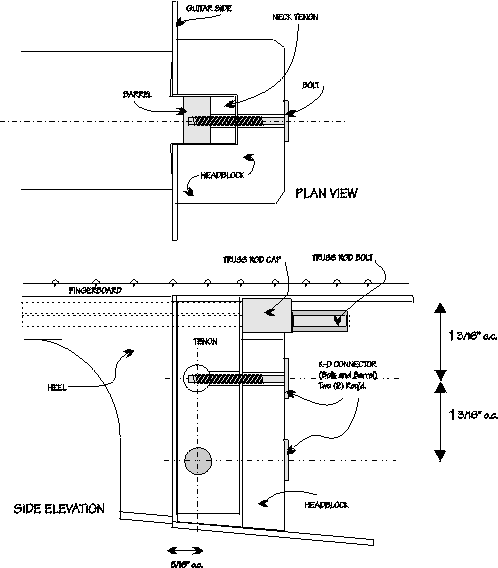
William Cumpiano's hardware-based neck joint

| This new hardware-based neck joint system
relies on a common brass hardware-store fastener called a "barrel bolt" or
"KD (for knockdown) fastener." Any good hardware store carries them. If you
don't have a good hardware store nearby, I found them on the web: Professional Hardware & Supply Co. Ask for
part numbers 36240 and 38220.The bolt usually comes in an elegant antique bronze finish RECOMENDED
FOR PEOPLE BUILDING A GUITAR FROM MY BOOK: My guitarmaking textbook was first published in 1985, and has gone into six editions without a major revision. Well, its time. This is it: but instead of republishing an entire edition, I'm just posting the first major revision to this page. Over the years, I've received quite a bit of mail from amateur builders struggling with the pinned mortise and tenon neck-joint system detailed therein. Its major drawback: the pinholes in the neck tenon must be offset by a minute amount to snug the neck down and into the soundbox. So how much is "minute," exactly? I learned the system in the Gurian workshops during the early seventies. The system was reportedly adapted by Michael Gurian and Walter Lipton from post-and-beam barn construction. In this ancient joint, oak pins are hammered through holes in the mortise into holes holes drilled in the tenon, holes drilled slightly offset, thus drawing the two tightly and permanently together. On the barn, both mortise and tenon were massive, and the pin was knocked in with a hammer. The joint's guitar counterpart requires much greater finesse and precision. An offset of one to two sixty-fourths of an inch is correct: much more and the pin simply refuses to enter the tenon or, if it does, mayhem can ensue: the neck shaft can be drawn forcibly away from the fingerboard. This rarely happened at the Gurian shop: we all learned how to install it without problems. But, alas, hindsight has shown that it is not a good beginner's neck joint. I've become aware over the years that although some seemed to handle its challenges pretty well, other people using were stymied by the precision required for it to work properly, if not the number of special gadgets, fixtures and implements that have to be fashioned to handle its assembly. So what are the alternatives? The tapered dovetail joint? Heavens, no! If there was ever a joint designed in hell, that one is it! There is absolutely nothing to be said for the joint except that it has been around for ever. The tapered dovetail is unnecesarily complex, requires endless fussing to get it to fit properly and as well, to disassemble it for resetting. So here we have a joint I like and can recommend--AND am using exclusively myself. I have put down my pinning pliers forever. For those purists who maintain that hardware-based joints are untested Johnny-come-latelies, allow me to refer you to Rennaisance lutes which often had a large, single wood screw holding the necks on. They've been around at least as long as mortise and tenon joints, tapered or straight. I'm very pleased with the barrel bolt: It works fabulously well: its strength is more than adequate to the requirements; it does not budge, even after only gently tightening it. It is SO easy to construct, assemble and disassemble. Anybody want to debate the merits/demerits of this system vis-a-vis any other? I'm game. |
[Sorry, folks but the
dimensions above, I'm told, are hard to read. They are: First barrel center point measured
vertically from the top of the tenon: 1 3/16" on center. Second barrel center point
measured vertically from the center of the first: 1 3/16"on center. Centerline for
both barrels measured horizontally from back edge of heel: 5/16" on center.] KD Connector Neck Joint
I think the drawing is self explanatory. Drill the barrel and bolt holes in the neck blank on the drill press while it's square BEFORE sawing the tenon and shaping the heel. The hole in the tenon for the barrel should be located as close to the back surface of the heel as possible, leaving as much tenon "meat" as possible behind the barrel for strength. Drill the tenon hole so the barrel fits tightly (they conveniently provide a screw slot on one end so you can orient the threaded hole properly). Drill the holes for the bolt oversize so the system will accomodate misalignments. The only warning which is appropriate relates to tightening the bolt. A long-handled 5/32" hex Allen head wrench can be manipulated through the soundhole. Finger tight is quite sufficient. Don't bully it or crunch it down: not only is this unnecessary, but it may conceivably break the tenon. One more point: If you fear your customers might mistake the bolt for a truss rod adjuster and start to crank them, warn them or inlay the bolt head and lightly tack a "cap" of matching wood over them to keep them from prying eyes.
"YES BUT IS IT STRONG ENOUGH?" Check this out: MarcC18642@aol.com wrote: William R. Cumpiano replies: This is quite a testimonial given that the actual stress across the joint is applied
|